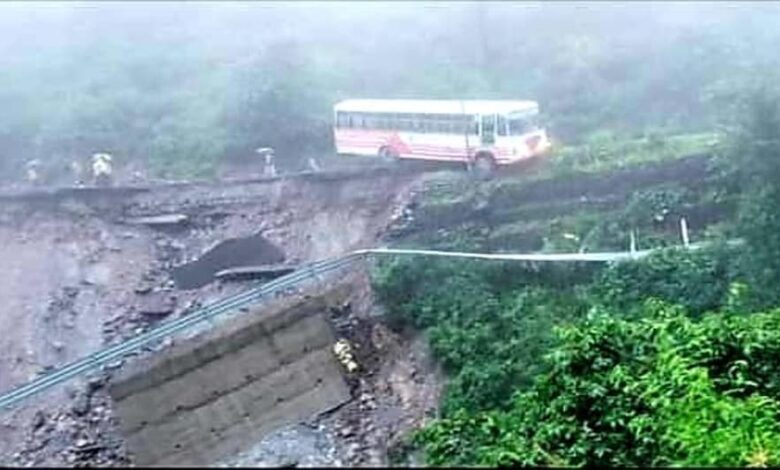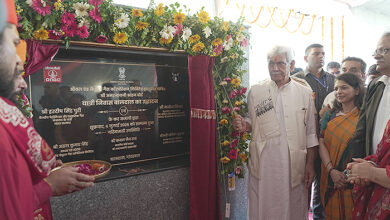Monsoon Fury 2023: Climate Change Makes Extreme Events New Normal
At present, extremely heavy rainfall is wreaking havoc across North-West India

PIC COURTESY : i GLOBAL PUNJAB
The scale of the rise in extreme weather events in India has been charting new highs with every passing year. 2023 began on a hotter note, with temperatures in February breaking the 123-year-old record. The humid heatwave in April and June over East and Central India were made 30 times more likely due to climate change. Then the formation of cyclone Biparjoy lasted for 13 days in the Arabian Sea and became the longest-duration cyclone since 1977.
At present, extremely heavy rainfall is wreaking havoc across North-West India. Incessant rains have triggered flash floods and landslides across Himachal Pradesh, while Delhi has recorded the highest rains in the last 40 years. Both meteorologists and climate scientists have been blaming increasing levels of global warming for a steep increase in extreme weather events.
“The ongoing spell of extremely heavy rains is due to the alignment of three weather systems, Western Disturbance over Western Himalayas, cyclonic circulation over northwestern plains, and Axis of Monsoon trough running across Indo-Gangetic Plains. This alignment is not happening for the first time and is the usual pattern during the Monsoon. However, global warming-led changes in Monsoon patterns have made a difference. There has been a constant rise in both land and sea temperatures, which has increased the capacity of the air to hold moisture for a longer time. Thus, the role of climate change in the increasing extreme weather events in India has been strengthening with each passing year,” said Mahesh Palawat, Vice-President – Meteorology and Climate Change, Skymet Weather.
Several reports and researches have already established the impact of climate change on Indian Monsoon patterns. However, it has also been tampering with atmospheric as well oceanic phenomena, which has further multiplied the implications of global warming.
“There have been extreme weather events earlier as well, but 2023 has been a unique year. Global warming is making a significant contribution but there are some other factors as well. Firstly, El Nino has taken shape, which is amplifying global temperatures. Secondly, wildfires have been in three times larger areas, releasing three times of carbon into the atmosphere, and increasing greenhouse gases. Thirdly, North Atlantic Ocean is in a warmer phase. Fourth, the Arabian Sea has warmed unexceptionally since January, infusing more moisture over North-Northwest India. And lastly, the upper-level circulation pattern is also unusual, which forces local surface circulations, bringing rains like the one we are witnessing across north and central India,” said Dr Raghu Murtugudde, Earth System Scientist and Visiting Professor at IIT-Bombay.
According to the Ministry of Earth Sciences report, ‘Assessment of Climate Change over the Indian Region’, overall monsoonal rainfall is projected to become more intense in future, and to affect larger areas mainly due to the increase in atmospheric moisture content with temperature. The frequency of localized heavy rain occurrences has significantly increased over central India, which is partly attributed to changes in the availability of moisture due to greenhouse gas-based warming, aerosols, stability of the atmosphere and increasing urbanization. Global as well as regional models project an increase in seasonal mean rainfall over India while also projecting a weakening monsoon circulation.
Since the middle of the twentieth century, India has witnessed a rise in average temperature; a decrease in monsoon precipitation; a rise in extreme temperature and rainfall events, droughts, and sea levels; and an increase in the intensity of severe cyclones, alongside other changes in the monsoon system. There is compelling scientific evidence that human activities have influenced these changes in regional climate.
“We all know that both global surface and ocean temperatures have been increasing, resulting in more evaporation. This has aggravated the rain manifold. Indo-Gangetic plains have been receiving lots of moisture from the Bay of Bengal as well as from the Arabian Sea. This continuous supply of moisture feed to the weather systems leads to increased rains, which also results in extreme weather events,” said Krishnan Raghavan, Scientist-G, Director, Indian Institute of Tropical Meteorology (IITM).
Dr Raghavan further stressed on the need of research on other global factors that impact circulations affecting Indian weather. “There is a possibility of another factor known as Arctic amplification. Polar regions have been heating at an alarming rate, leading to glacial ice melt. Due to this, mid-latitude circulation patterns have been affecting atmospheric circulation patterns in mid-latitude and the tropics. We need to have more research on this but its contribution cannot be ruled out on changing weather patterns in India.”
The IPCC Report, ‘Weather and Climate Extreme Events in a Changing Climate’ had already warned that summer and monsoon precipitation will also increase and become more frequent. The Indian sub-continent will have a 20 percent surge in extreme rainfall events. The projections suggest that rainfall will become incessant and erratic leading to floods, depressions will intensify into deep depressions, and cyclonic events will become more frequent across eastern and western coasts. Further, if global warming increases, some compound extreme events, with a low likelihood (of occurrence) in past and current climate, will become more frequent, and there will be a higher likelihood that events with increased intensities, durations and/or spatial extents, unprecedented in the observational record, will occur (high confidence).
The warming in the western Indian Ocean is associated with increases in moisture surges on the low-level monsoon westerlies towards the Indian subcontinent, which may lead to an increase in the occurrence of precipitation extremes over central India. There is a significant increase in heavy rainfall (>100 mm day– 1) and a significant decrease in moderate rainfall (5–100 mm day–1) in central India during the South Asian monsoon season. Increases in flood frequency or magnitude are identified for south-eastern and northern Asia and India.
The writer of this article is Dr. Seema Javed, an environmentalist & a communications professional in the field of climate and energy




